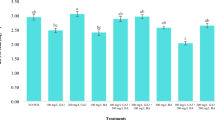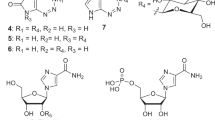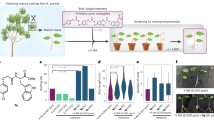Abstract
Hansch and Muir1 have shown that a free ortho position is required for growth regulatory activity in the phenoxyacetic acid series (Avena straight-growth test), and have suggested that the active compound reacts “with a substrate at two points, first by means of the carboxyl group, and second at a position ortho to the attachment of the carboxyl group”. This explanation does not account for Wain's finding2 that one hydrogen on the α-carbon atom was essential for activity (Went pea test).
This is a preview of subscription content, access via your institution
Access options
Subscribe to this journal
Receive 51 print issues and online access
$199.00 per year
only $3.90 per issue
Buy this article
- Purchase on Springer Link
- Instant access to full article PDF
Prices may be subject to local taxes which are calculated during checkout
Similar content being viewed by others
References
Plant Physiol., 24, 358 (1949).
J. Sci. Food Agric., 2, (3), 101 (1951).
Baker, L., “Tautomerism”, 107 and 154.
Biochem. J., 36, 737 (1942).
“Plant Biochemistry”, 458 (1950).
Author information
Authors and Affiliations
Rights and permissions
About this article
Cite this article
RHODES, A., ASHWORTH, R. Mode of Action of Growth Regulators in Plants. Nature 169, 76–77 (1952). https://doi.org/10.1038/169076a0
Issue Date:
DOI: https://doi.org/10.1038/169076a0
This article is cited by
-
Effect of Plant Regulators on the Incorporation of Phosphorus-32 into the Alcohol-soluble Fractions of Pea Seedlings
Nature (1966)
-
Occurrence of Indole Compounds containing Phosphorus in Etiolated Pea Seedlings
Nature (1963)
-
Effect of Indole-3-Acetic Acid (IAA) on Phosphorus Metabolism in the Avena Coleoptile
Nature (1961)
-
Darstellung und Eigenschaften aktivierter Verbindungen der Indol-3-essigs�ure
Die Naturwissenschaften (1961)
Comments
By submitting a comment you agree to abide by our Terms and Community Guidelines. If you find something abusive or that does not comply with our terms or guidelines please flag it as inappropriate.



